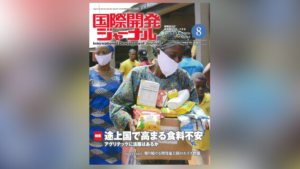IDJ ENGLISH - Urban Development Special
Think again what the SDGs suggest
Creating a city friendly to all, including the vulnerable, should be Japan’s highest wisdom
Mr. Katsuhide Nagayama, Representative Managing Director of ALMEC Corporation, has been engaged in various urban developments in Asia and around the world, including the urban development project in Ulaanbaatar, Mongolia, supported by Japan’s Official Development Assistance (ODA). In the post-Corona era, what should urban planning be like? Mr. Nagayama speaks out.
No dramatic paradigm shifts will be placed
Even with the spread of the COVID-19 Pandemic, there will be no dramatic paradigm shifts in the urban development undertaken by Japanese at home and abroad. After all, the influence of the COVID-19 virus is not so serious in Southeast Asian countries. Besides, the Japanese is not keen for learning any lesson from their mistakes and making use of them next time. Japan has experienced global pandemics such as the Spanish flu in the past that caused 390,000 deaths, but the way of urban development in Japan has not been changed significantly.
However, after experiencing the COVID-19 Pandemic, it can be expected that there will be some changes in the way of thinking and values for town planning. The key is to think again what the Sustainable Development Goals (SDGs) suggest. In the SDGs, Goal 11 states “Building livable and sustainable cities and communities for all”, and the concepts of sustainable, inclusive and resilient living are among them. With this as a starting point, we should consider, along with developing countries, what we should do in terms of future urban development.
Hygienic safety becomes more important in developing countries
It is expected that the concept of “health and hygiene” and “prevention of epidemics” will be introduced as conditions for a safe and comfortable city. The first point is what to do with the urban space. There are proper densities in cities, and “100 people per hectare” is a rough standard for urban areas. In the case of Shinjuku, Tokyo, there are 300 to 400 people per hectare, but such “high density” settlements may create urban attractions of the city. Of course, in a pandemic, it is necessary to secure a “quarantine distance” such that the distance between people is 2 m. However, it is unfavorable from the standpoint of city planning to continue this trend even after the end of the COVID-19 Pandemic. More attention needs to be paid to a population density that guarantees a comfortable life.
In urban planning, it is a crucial task to create “open space” such as green parks and recreational space. While tele-working at home, many may find that there are various open spaces around their homes, but the size of the park per person is 30㎡ in Vancouver and 12㎡ in Paris, while Tokyo’s 23 wards is very narrow, 3㎡. In the future, there will be a growing tendency in urban planning to increase the number of open spaces, create more relaxing environment to make the cities more livable in Japan.
The second viewpoint is the accessibility of transportation. As one of the targets of Goal 11 of the SDGs, the move to make public services accessible to all, including women, children and people with disabilities, will be a more important theme. Many people were enforced to be inconvenienced in using public transportation under the official requirement at the state of emergency to protect from lessening epidemic risks. But the vulnerable people, such as the elderly, the sick and the handicapped, were unable to move around easily. We need to consider how to create an inclusive system so everyone can catch public transportation services. Although provision of curative services against infectious diseases belongs to professionals of medical and health, building of universal accessibility to public services for all people, including medical and health institutions, must be an urban planning task.
The third point is to develop “preventative environment” resilient against infectious diseases. In developing countries, it may be more important. For example, viruses that cause malaria and dengue fever are transmitted by mosquitoes, but because mosquitoes breed in the water accumulated in the garbage left in the city, the establishment of a waste treatment system is one of the measures to prevent such epidemics. It is also important from the perspective of governance regarding how local governments will deal with the maintenance and management of urban environmental infrastructure including sewage and drainage facilities.
Incorporating the perspective of local residents
In order to achieve urban development visions supported by new values, it is necessary to incorporate a bottom-up approach that absorbs the opinions of residents and local governments, including the weak, and reflects their needs in city planning and policies.
The “ Project for Sustainability Future City Initiatives in Thailand” (July 2015 to present) sponsored by the Japan International Cooperation Agency (JICA), aims to achieve local urban development using such a bottom-up approach. The project selected six model cities and initiated them to identify their own development goals/themes in future, taking into account their latent potentials and constraints in several areas such as tourism, education, and transportation, then formulate a future sustainable city plan. At that time, all local actors, such as residents, NGOs, and university professors, as well as local governments, discussed “what to do with their own town” together, and created a future action plan.
What I emphasized in this effort was to create a “legend” that the local people could proudly say to their next generation that they “thought of this vision and participated in their town's development for the vision.” In the meantime, the next generation will develop a sense of “I want to cherish this town created by my parents.” I think that urban planning is the work of handing over to the next generation, and such a relay of social values from one generation to the next could make the city sustainable.
We also adopted this bottom-up approach for the formulation of the urban development master plan in Ulaanbaatar City. Nowadays, many cities are trying to take a participatory planning method with a recognition that a top-down approach cannot bear any sustainable urban plan strongly endorsed by local people. Interestingly, the Philippines is a pioneer in this approach and has much to learn. Under the Local Autonomy Law, the country has a system for urban development led by local governments. The activities of NGOs that deliver voices of residents to local governments are also active. The issue is that people are less aware of legal compliance, but the legal framework, itself, is well prepared, individual abilities are high, and the independence of local autonomy is functioning properly. There are many experiences and lessons to learn in this country.
What is truly “Smart”
Finally, I would like to talk about smart cities, which have become a hot topic in the field of urban development in recent years. It seems that the smart city advocated by the Japanese government means a city that utilizes and places Japan’s cutting-edge technologies, but the important thing to remember is the inclusion of the weak. Japan has been promoting the creation of an “inclusive” city where everyone, including persons with disabilities, can live comfortably by actively incorporating universal design into urban development.
“Higher quality infrastructure” sounds good, but I think Japan should cherish these warm parts as requisite values rather than hard facilities. By doing so, there will be a movement to further enhance its value, and we can send a message to cities in developing countries, “Why don’t you try it?”, thereby leading to a smart partnership with them. Perhaps we should have more discussions on the definition of what is truly smart.
International Development Journal 2020 July edition
*****以下、日本語原文*****
SDGsが示唆するものを見直せ
弱者に優しい都市づくりを日本の誇るべき知見に
(株)アルメックVPIの代表取締役を務める長山勝英氏は、政府開発援助(ODA)によるモンゴルの首都ウランバートルの都市開発プロジェクトなど、アジアを中心にさまざまな都市開発を手掛けてきた。ポスト・コロナ時代において、都市計画作りをはじめとするまちづくりは、どうあるべきなのか。長山氏の展望を聞いた。
劇的なパラダイム・シフトはない
新型コロナウイルスの感染拡大を受けても、国内外で日本勢が手掛ける都市開発に劇的なパラダイム・シフトが起こることはないだろう。と言うのも、東南アジア諸国は新型コロナの影響がそれほど深刻ではない。それに、日本人は失敗から教訓を得て、次に生かすことが苦手だ。日本は過去にもスペイン風邪などの世界的パンデミックを経験し、39万人もの死者を出したが、日本の都市開発の在り方が大きく変わることはなかった。
しかし、コロナ禍を経験して、まちづくりの理念や価値観の置き方にある程度の変化は期待できる。重要なのは、持続可能な開発目標(SDGs)が示唆していることを今一度見直すことだ。SDGsでは目標11で「住み続けられるまちづくりを」が掲げられており、その中には持続可能(サステナブル)、包摂的(インクルーシブ)、強靭(レジリエント)といった概念が散りばめられている。ここを出発点として、これからのまちづくりをどうしていくべきか、開発途上国とも一緒に考えていくべきだ。
途上国では「防疫」がより重要に
安全な快適都市の条件として「保健衛生」や「防疫」という概念が持ち込まれる場合が増えてくると思われるが、その際3つの視点を重視したい。1つ目の視点は、都市空間をどうするかである。都市には適正密度があり、「1ha当たり100人」が市街地の大体の目安になっている。これが東京の新宿になると1ha当たり300~400人になるが、こうした“高密度”は、都市の魅力の一つでもある。もちろん、パンデミックのような時には人と人との間の距離を2mあけるといった“防疫距離”を確保するのは必要だ。しかし、新型コロナが終息した後もこうした傾向を続けるのは、都市計画に携わる立場から言えば好ましくはない。快適な生活を保証する人口密度にもっと注意が向けられる必要がある。
都市計画には緑地公園といった「オープンスペース」という考え方がある。在宅勤務をする中で、自宅の周囲に多様なオープンスペースがあることに気付いた人も多いだろうが、規模は一人当たりの公園面積がバンクーバーで30㎡、パリで12㎡ ある一方、東京23区は3㎡と非常に狭い。今後、もっとオープンスペースを増やして、リラックスできる環境を作り、都市にゆとりを持たせようという傾向が強まってくるだろう。
2つ目の視点としては、交通のアクセシビリティがある。SDGsの目標11のターゲットの一つに挙げられているように、女性や子供、障害者などすべての人が公共サービスにアクセスできるようにする動きは、より重要なテーマになるだろう。緊急事態宣言において公共交通機関の利用自粛が呼び掛けられた結果、多くの人が不便を負ったが、特に老人、病人、障害者といった交通弱者が容易に移動できない状況に追い込まれた。誰もが公共交通サービスを受けられるよう、包摂的なシステムをどう作るか検討する必要がある。感染症への対応は医療・保健分野に属する話ではあるが、医療機関への円滑なアクセス手段の構築などは都市計画の仕事であろう。
3つ目は、「防疫的環境」という視点だ。途上国では、より重視されていく可能性がある。例えば、マラリアやデング熱の原因となるウイルスは蚊が媒介するが、都市で放置されたゴミに溜まった水の中で蚊が繁殖するため、廃棄物処理システムの整備は防疫の一つになる。下水・排水施設なども含めた都市環境インフラの整備と維持管理に自治体がどう対応していくか、ガバナンスの観点も重要だ。
地域住民の視点も取り入れる
新しい価値観に支えられたまちづくりを達成するには、弱者を含めた住民や地方自治体の意見を吸い上げ、都市計画や政策に反映する、ボトムアップのアプローチを取り入れることが必要だ。
我々が主体となって実施している国際協力機構(JICA)の「タイ国未来型都市持続性推進プロジェクト」(2015年7月~現在)は、まさにボトムアップのアプローチによる地方の都市開発を目指したものだ。同プロジェクトでは6つのモデル都市を選定して、観光、教育、交通など各都市でテーマを選定し、将来の持続可能な都市計画を策定した。その際に、住民やNGO、大学教授など、地域の各アクターたちと自治体が一緒に「自分たちのまちをどうするか」を議論し、将来ビジョンから具体的なアクションプランまで作成した。
この取り組みで私が重視したのは、現地の人たちが次の世代に「自分たちはこのように考えてまちづくりに参加した」と誇れる、“伝説”を作り上げることだ。私は、都市計画とは「こうした価値を大切にして生活していきませんか」というのを、次の世代に引き継ぐ作業だと考えている。そのために「何が問題か」を問いかけつつ、解決策などを議論していく。そうした中で次の世代に「親達が作ったこのまちを大切にしたい」という意識が育まれて、まちは持続可能となると考えている。
このボトムアップ・アプローチは、ウランバートルでの都市計画マスタープランの策定でも取り入れた。ODAによる都市計画では、昨今、多くがこのアプローチを採用している。面白いことにフィリピンは、このアプローチの先駆者であり、我々が学ぶべき知見を多く持っている。同国では、民主的な地方自治法の下で、地方自治体が主体となった都市開発の制度が整っている。住民の声を地方自治体に届けるNGOの活動も活発だ。人々に法令順守の意識が低いことが課題であるが、法的枠組み自体はよく整備され、個々の能力は高く、地方自治の主体性はしっかり機能している。学ぶべき点は多い。
本当の“スマート”とは
最後に、近年、都市開発分野でよく話題に上がるスマートシティに関して話したい。日本政府が掲げるスマートシティは、どうやら日本が持つ最先端の技術を活用した都市を意味しているようだが、やはり忘れてはならないのは弱者の包摂だ。我が国は、都市開発にユニバーサル・デザインを積極的に取り込むなど、障害者を含めたすべての人が暮らしやすい“優しい”都市づくりが進められてきた。
「質の高いインフラ」もいいが、日本はもっと、こうした温かみのある部分を価値として大切にしていくべきではないだろうか。そうすることでその価値をさらに磨いていこうという動きも出てくるし、海外に向けて「やってみてはどうですか」と発信していける。そういうことこそ“スマート”なのではないだろうか。本当のスマートとは何か、もっとみんなで議論をしていくべきだと思う。
『国際開発ジャーナル』2020年8月号掲載記事



